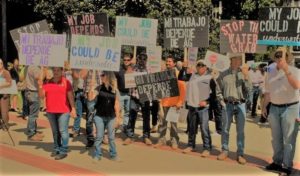The Water Grab
By Charles A Hice
 Last month farmers, families, and politicians on both sides of the aisle marched on Sacramento to rally against the California Water Resource board and its policies lately that have been negatively affecting the central valley among others.
Last month farmers, families, and politicians on both sides of the aisle marched on Sacramento to rally against the California Water Resource board and its policies lately that have been negatively affecting the central valley among others.
The rally was in opposition to the Water Resource boards proposal that more than 40% of all available water from the Delta be further restricted for use from and farming and allowed to be naturally released – meaning eventually finding its way into the ocean unused.
The rally saw more than 1,500 people joining its ranks from all over California. They took busses and trains from all over the state in support. Politicians and grassroots groups, such as My Job Depends On Ag, made attendance, among farmers and families.
The water board plan is meant to help the failing ecological systems of the delta among others, a fight that has been failing for the last 50 years but as continued to burden farmers and families in the San Joaquin Valley.
Assemblyman Adam Gray, D-Merced was in attendance, and stated, “This plan will decimate the economy of the Central Valley. We stand to lose $1.6 billion and over 6,000 jobs in my community alone.”
The benchmark test for the health of the deltas and estuaries that southern and central California in part relies on has been the measurement of the delta smelt population. This measurement is in its worse decline since 1968 and the fish species is virtually on the brink of extinction.
It’s not this tiny fish that is the main concern, however, but how it is ultimately considered a massive part of a greater ecosystem and basic staple in the food chain of that ecosystem. However, in regard to water, environmentalists agree that water diversion is not the only contributing factor to the depletion of the northern fish population nor may it be the biggest concern. There are other factors to consider such as invasion of non native fish species, pollution, surrounding human impediment, among other things.
But the restricted use of water has not provided any relief for this smelt nor has it given any indication that further restriction will help. It seems as though the water board has decided to ignore all the facts and further hurt Californians and Ag despite all reasoning.
Congressman Tom McClintock may have said it best in this statement, “We live in one of the most water rich regions of the country, and yet our families are now facing the threat of catastrophic water shortages and year-round water rationing. Not because of any act of God, but because of breathtakingly stupid acts of state government. THAT we can change.”
The issue is more severe than simply water restriction. This entire situation goes into the very state of the California canal, dam, and reservoir system as well. Our canals, dams, reservoirs, and pumps are outdated and in disrepair. It is an infrastructure in decay possibly worse than the highway and bridge systems. Even without the water boards restrictions it’s still unlikely we will be able to store the bulk of all that lost water anyways.
But to simply wash such a vast amount out into the ocean with further restriction on pumping it through the San Joaquin valley is absolutely ludicrous and has been a jaw dropping decision that virtually no one understands.
Farmers are fighting for their livelihood, and have become leading water conservationists. Yet the water board seems to be especially trying to attack the Agricultural industry in California with its latest proposal for reasons beyond explanation or understanding. In part this is because the states proposed water restriction plans will directly interfere and negatively affect other water storage plans and projects such as the states New Melones Project – which is attempting to create a better dam and power plant operation on the Stanislaus River. This particular project would help with water storage, flood control, and water quality. But it is threatened with the water boards proposal.
The water board plan caused a stir with the Department of Interior, which has threatened a lawsuit against the state. The department also stating the plan would “cripple the Central Valley’s economy, farms and community.”
The water boards proposed restriction are both laughable and frightening. The water board seems to be completely disconnected with any real understanding of how it is hurting Californians, nor does it appear to understand the real problems the state faces.
On behalf of the Department of Interior, Rep. Jeff Denham stated, “Under Sacramento’s plan, the Valley will suffer skyrocketing water and electricity rates. After a decade and millions of our money spent on a study that they required, the board ignored the science based proposal that would save our fish while preserving our water rights. We will not allow them to take our water and destroy our way of life.”
First, the board’s proposal is a band-aid fix on the cut artery that is California’s entire water management infrastructure. IT fails to see the real problem and offer any viable solution. California’s water management infrastructure is in decay and needs investment.
Second, it directly destabilizes other water conservation projects. It hinders these projects, and further creates a relying need on the “status quo”. This is an ironic twist to say the least. In effect, this will give the water board a monopoly of control on California water. But with the current state of affairs this system will eventually break as more and more people need more and more water.
Thirdly, the water board’s primary intention to save a section of the environment is doomed to fail. This is because it is a misunderstanding of the total issue. And it cannot possibly work, because it has not worked for the last 5 decades.
The issue isn’t Fish vs Farmer, the issue is California water being mismanaged by people that simply don’t appear qualified to make these decisions. Or, at the very least, aren’t being transparent enough in their understanding, reasoning, or planning.
By Charles A Hice
Contributor and Editor Ag Expo Magazine

